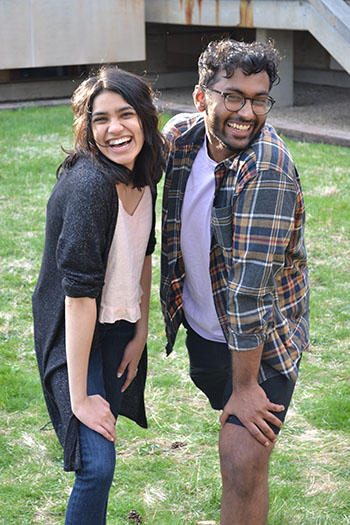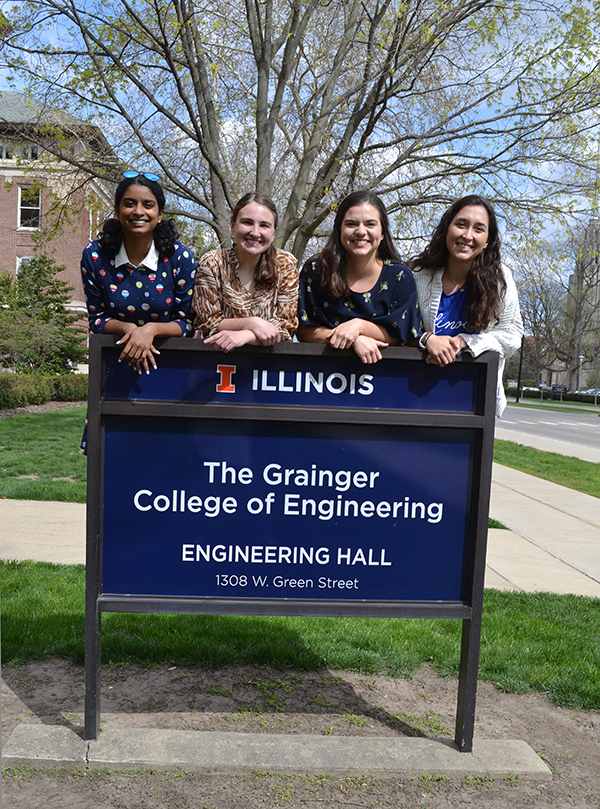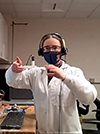Paper2Tree Plants Trees, Sows Seeds Regarding Potential Careers in Engineering
November 28, 2018

As part of the Paper2Tree outreach activities, MechSE Outreach Coordinator Joe Muskin (left), works with a King student who is using TinkerCAD to design a keychain which will then be 3D printed.
 King students shovel mulch on the Shingle Oak tree planted next to the school in King Park as part of the Paper2Tree project.
King students shovel mulch on the Shingle Oak tree planted next to the school in King Park as part of the Paper2Tree project. On Thursday, November 15th, a number of community-minded Mechanical Science and Engineering (MechSE) Professors participated in Mattia Gazzola’s Paper2Tree project, some for the second year in a row. The goal of the project is to enable these faculty to give back to the community in a couple of ways. First, as the Paper2Tree name implies, the professors hoped to make amends for the number of trees used up when publishing by having crews from two partners, the Urbana and Champaign Park Districts, on hand to plant two trees. The event also allowed these educators to give back to the community by sharing what they’re passionate about— teaching and research. But instead of working with today’s college students, they were interacting with tomorrow’s—fourth and fifth graders at Martin Luther King Elementary School in Urbana and fourth graders at Booker T. Washington STEM Academy (BTW) in Champaign.
The goal of Paper2Tree’s outreach was to expose youngsters to engineering via age-appropriate activities related to the professors’ research. For example, in the morning at King, Assistant Professor Chenhui Shao led Shalonda Carr's fifth graders in a cookie puzzle activity related to his manufacturing research. First, students received a plate covered with aluminum foil that concealed a different shaped cookie (either an “I”, a circle, or a star). Next, the students stuck toothpicks through the foil to determine whether or not there was cookie in various areas on the plate. The idea was to correctly guess their cookie’s shape with the fewest number of pokes. The best part was, they still got to eat the cookies whether or not they guessed correctly.
According to Shao, the activity was designed to teach concepts of spatial sampling and optimal measurement strategies, which are important in smart manufacturing so manufacturers can make optimal decisions and “use minimum resources to get maximum information about processes, stations, systems, factories, and supply chains,” he explains.

Assistant Professor Chenhui Shao explains how the cookie activity is related to his manufacturing research.
Regarding the outreach, Shao says educating the next generation of manufacturing engineers is crucial. Thus, he hoped to get some youngsters interested in his field early on to "engage a large and diverse manufacturing cohort through scientific discovery and education to manufacture innovative products and discover new knowledge that will in turn benefit the society.”
Carr’s fifth graders also got to experience 3D printing, courtesy of Joe Muskin, MechSE’s Outreach Coordinator. Using TinkerCAD, a computer-aided design software for kids, students designed a key chain, then got to watch as it was 3D printed in their classroom.
According to King teacher Shalonda Carr, having university folk visit her classroom is beneficial to her students as they not only share their expertise, but to expose the students to role models and potential career options.

During the Paper2Tree outreach's "Cookie" activity, King 4th and 5th grade teacher Shalonda Carr records the number of toothpicks her students used to determine the cookie's shape.
 King's Shalonda Carr works with a student who is using TinkerCAD to design a keychain.
King's Shalonda Carr works with a student who is using TinkerCAD to design a keychain.“Having other people that have an expertise in something outside of my field is good for them to see what we're learning in class isn't just about class,” she says. “It's about how they can extend this into maybe a university career or into a job that they want to have in STEM or anything else.”
Carr also appreciates having experts working on real-world issues come and interact with her students, whom she claims are “excited to see people who this is what they do all day long, and it's not like ‘This is an imaginary thing that I hope you can figure out that later on this is potentially a job.’ They see people who actually do this kind of work.”
Of course, one of the highlight of the morning was visiting the Shingle Oak tree that had just been planted, where the kids were delighted to shovel chips to mulch it. (The Urbana Park District folks were also delighted to have them shovel the chips!)
In the afternoon, several MechSE professors did activities with fourth graders at BTW in Champaign. BTW fourth graders were exposed to Gazzola’s robotics research during a robotic fish activity. During an activity led by Assistant Professor Aimy Wissa and some of her students, fourth graders built (and flew) bio-inspired gliders.
In addition, Jiho Kim, a PhD student in Assistant Professor Alison Dunn’s research group, did an activity with fourth graders about corrosive wear. Because a tree was donated in celebration of a paper he recently had published, “Thixotropic Mechanics in Soft Hydrated Sliding Interfaces," Kim was invited to facilitate the outreach event. His activity introduced the concept of wear and basic experimental procedures to young students.
For the activity, students measured the weight of lollipops after rubbing them against sandpaper, putting them in water, and licking them, then recorded how the lollipops were reduced in weight. The activity was directly related to his research area, tribology, which is the study of surface phenomena in sliding interfaces. Kim shares why he participated in the outreach.
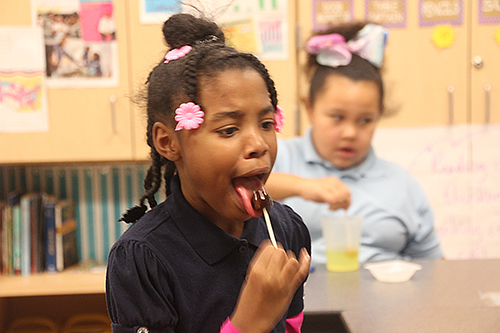
A BTW fourth grader conducts research to determine the degree of corrosive wear licking will have on her lollipop. (Photo courtesy of Joe Muskin.)
“I just wanted to have an experience of reaching out to society using my knowledge from my PhD study. I got a chance to do this, so I participated.”
Kim shares how he personally benefitted from the outreach, especially by learning to communicate his research in ways the children could understand:
“As a PhD student, I always present my work to professors or graduate students, who are familiar with technical words and concepts. In the outreach event, I was surprised to realize how hard it is to explain the concepts to young students. It was a really meaningful experience that made me think about easier and more efficient way of describing ideas. Also, watching the young students enjoying learning was a pleasant experience.”
His tree was planted at Douglass Park, close to the school during the week of the Paper2Tree outreach activities. However, because of wintry weather, BTW students did not participate in the planting.
According to Lauren Johnson, BTW’s STEM Teaching Specialist, who worked with Joe Muskin to coordinate the activities, her district is very fortunate to have a world-class university so close.
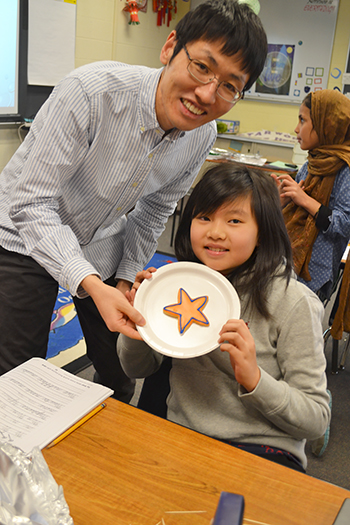
Assistant Professor Chenhui Shao (left), with the student who guessed the shape of her cookie with the fewest toothpicks.

A BTW fourth grader prepares to test her robotic fish.
“Our students get to work with people in a variety of STEM fields, connecting what we do in STEM to careers and further areas of study. Projects like this Paper 2 Trees event increase our students' engagement in learning and excitement about STEM.”
MechSE Assistant Professor Katie Matlack sponsored one of the trees, a Ginko that was planted in Champaign's Douglass Park. Regarding her participation, she says, “To me, it’s important to take an active role in giving back to my community. Paper2Trees does this by engaging elementary school students and in developing parks in the area…The tree sponsorship was a nice way to commemorate the first journal paper our research group published, by helping to sustain green spaces in our area.”
Regarding the outreach aspect, she reports, “Engaging elementary school students is important because it’s becoming increasingly important to expand STEM education in our country. I hope these events spark curiosity in students, and that students will become excited about STEM-related areas.”
Gazzola began Paper2Tree in November of 2017, by planting trees in Fall 2017, Spring 2018, then again in Fall 2018. To date, six new trees have been planted locally. There are now two in King Park next to ML King School in Urbana, and two in Douglass Park, next to BTW in Champaign. Plus, in spring 2018, the NCSA (National Center for Super-Computing Applications) planted a Swamp White Oak in Carle Park in Urbana to replace a diseased tree that had to be taken down. Also, courtesy of Christopher Senalik’s proud wife, a Fall Fiesta Sugar Maple is now producing some new wood in Scott Park in Champaign. She had a new tree planted to celebrate his PhD paper which, ironically, had to do with old wood: “Detection and assessment of wood decay – glulam beams and wooden utility poles.”
According to Gazzola, Paper2Trees has benefits besides proactively planting trees to replace the paper used by academia. For one, he considers outreach to be his responsibility, calling it “part of the mission of the university…so we do research; we teach students at college, but it's bigger than that, right? So that's why—that's one of our duties.”
Gazzola adds that it’s enjoyable. “It's fun,” he admits. “The kids like it, and it's nice when you bring them out and see the tree planted.”
Not only does the community gain trees and the kids get exposed to engineering; but Gazzola and his colleagues also benefit from the outreach. He admits that they are required to do outreach as part of their funding, such as through the National Science Foundation. So for him and some colleagues, Paper2Tree fills the outreach requirement niche:
“Then there's also the more selfish side of it," he acknowledges, "I get to go after federal grants. The outreach is very important…It's essential—a good outreach plan, which makes sense. It's a fair request. We're also incentivized to come up with something.”
All in all, Gazzola finds Paper2Tree to be quite rewarding, and is looking to the future: “I'm just happy this is going on and it was not just one thing last time. We plan to keep going with these…So every spring, plant some trees and in fall, have an event like this.
Author/Photographer: Elizabeth Innes, Communications Specialist, I-STEM Education Initiative
More: Champaign-Urbana Community, Faculty Feature, MechSE, 2018
For additional I-STEM web articles about the Paper2Tree program, see:

A King student uses TinkerCAD to design her keychain during the 3D printing activity.
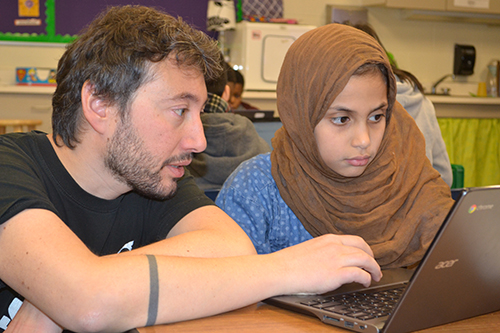
Mattia Gazzola (left) helps a King student create a keychain using TinkerCAD.
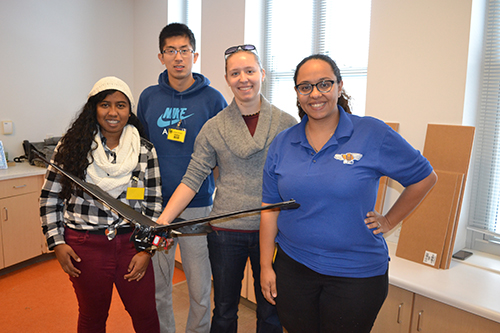
MechSE Assistant Professor Aimy Wissa (right) and her students show off the glider they brought to demonstrate to the fourth graders.

Jiho Kim interacts with BTW fourth graders as the students either rub their suckers on sandpaper and/or lick them as part of his corrosive wear activity. (Photo courtesy of Joe Muskin.)
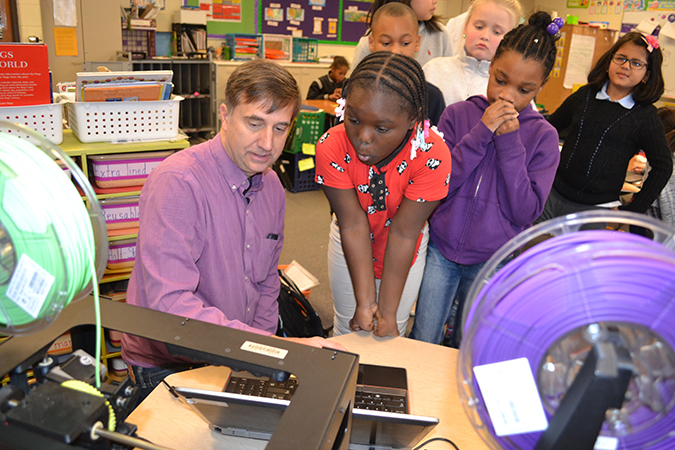 Joe Muskin (left) and several King students watch as a 3D printer cranks out the keychains they designed.
Joe Muskin (left) and several King students watch as a 3D printer cranks out the keychains they designed.
During Paper2Tree's morning outreach session at King School, Mattia Gazzola explains his research to Carr's students.


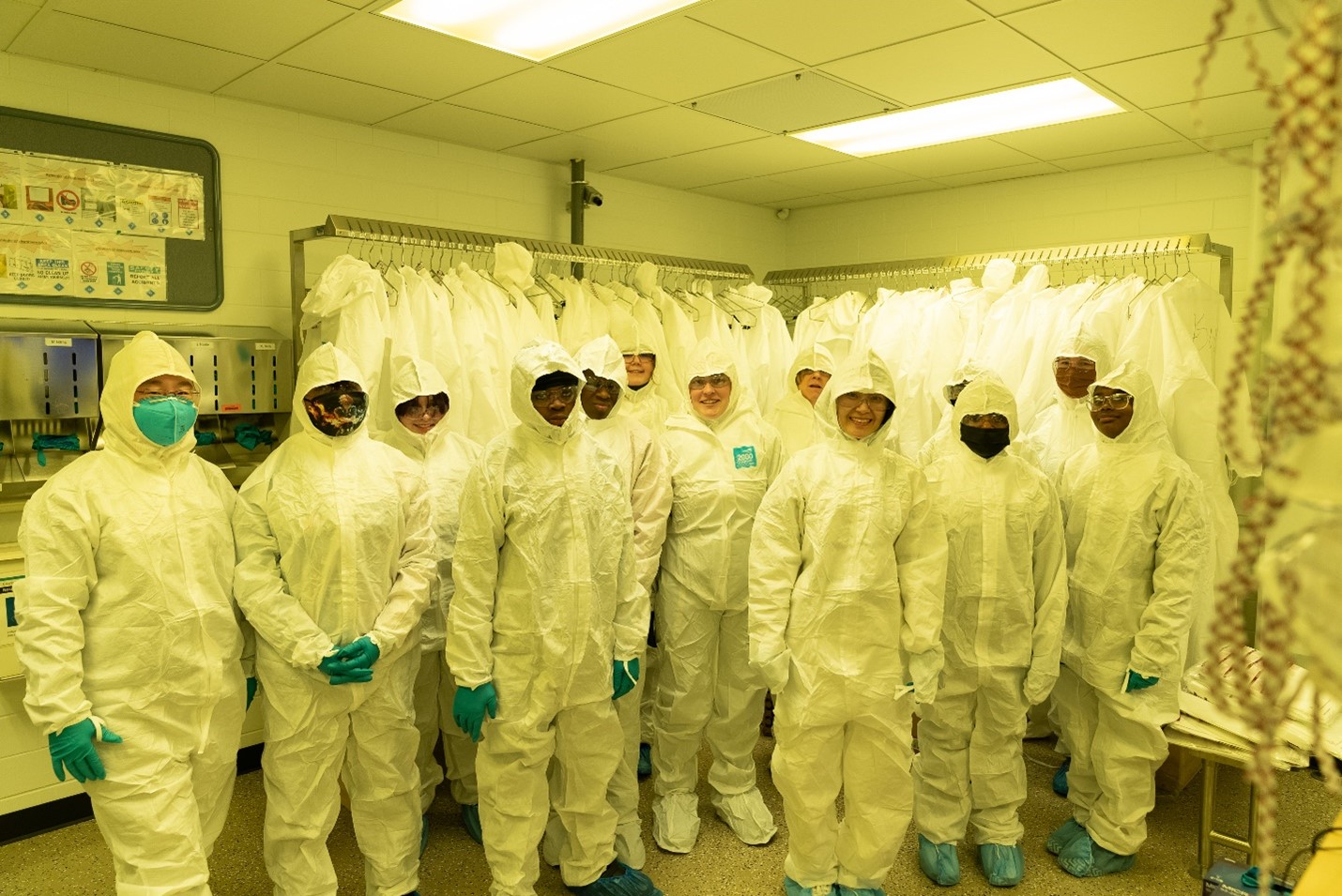
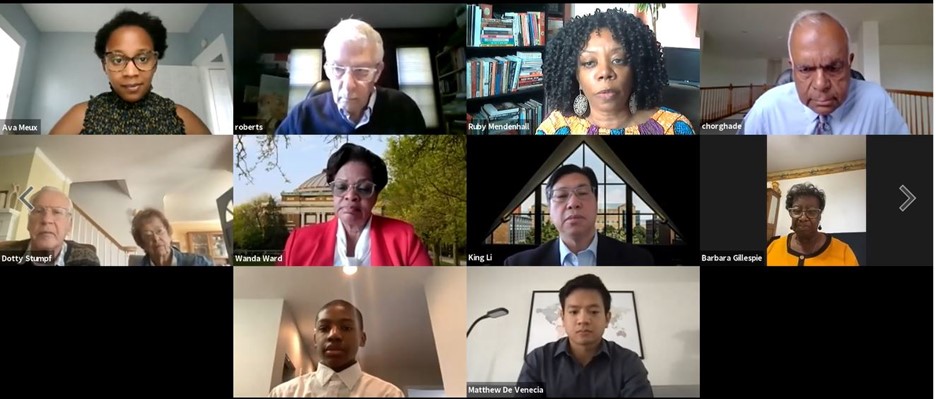
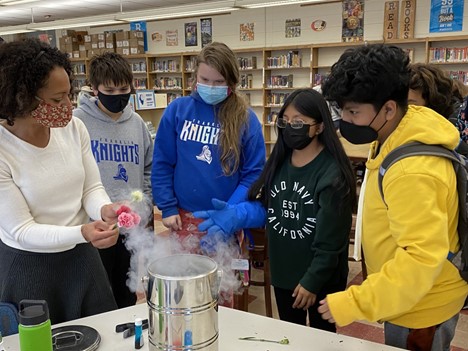


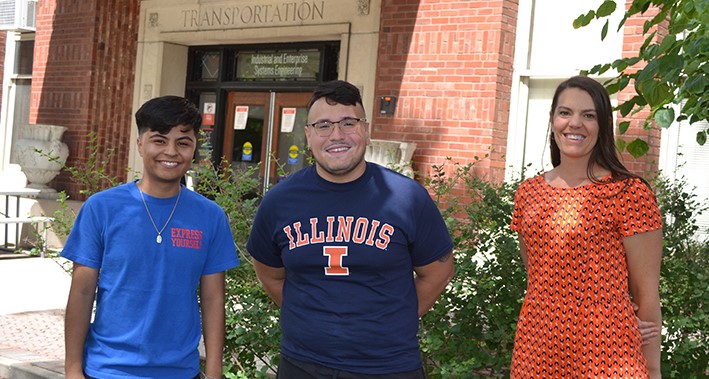



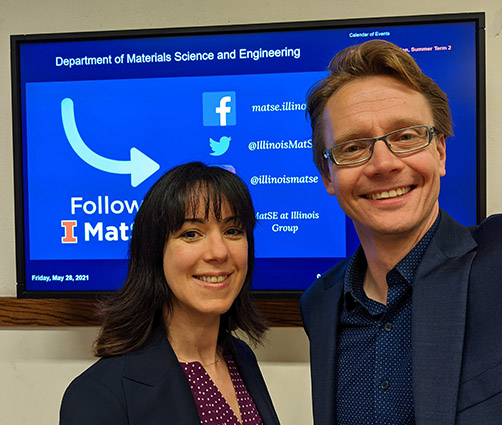

.jpg)




